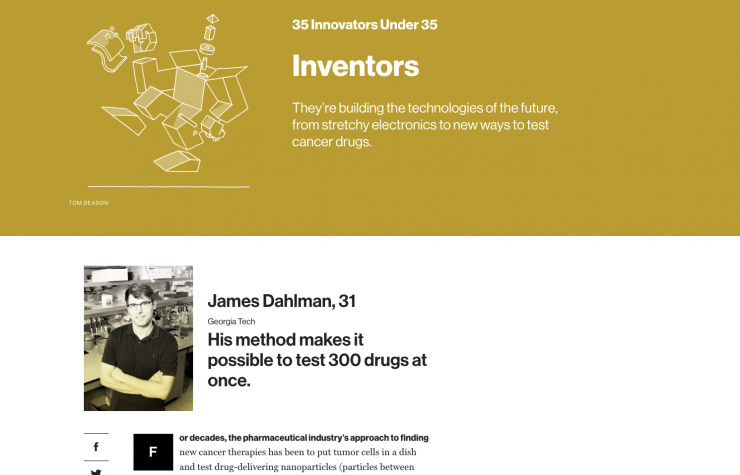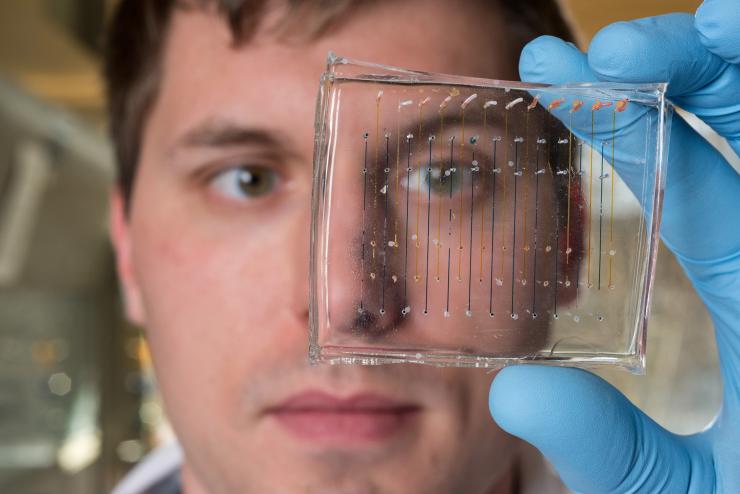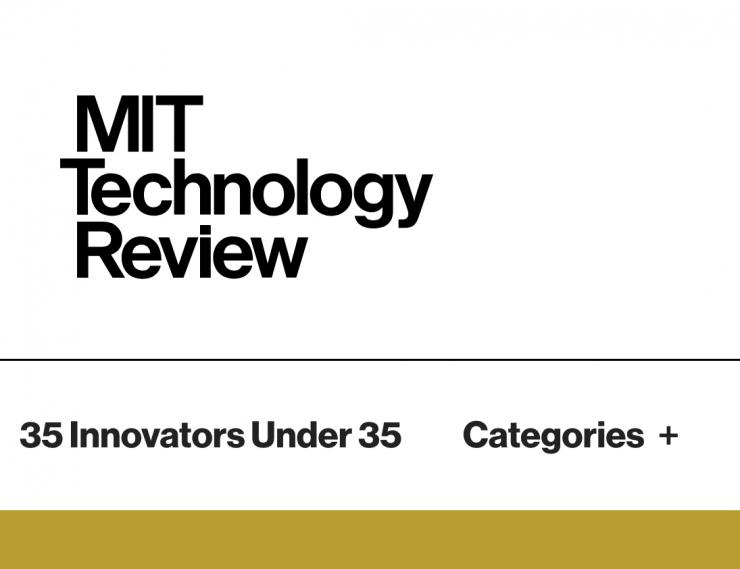MIT Technology Review Applauds Georgia Tech’s Dahlman in ‘35 Innovators Under 35’
Jul 02, 2018 — Atlanta, GA

MIT Technology Review's "35 Innovators Under 35" applauded James Dahlman as a great inventor in its 2018 annual edition. Dahlman is synonymous with DNA-barcoding at Georgia Tech. The method tests hundreds of drug-delivering nanoparticles at once in vivo. Credit: MIT Technology Review
When a recognition makes your name fit comfortably into the same sentence with Facebook’s “Mark Zuckerberg” or Google co-founder “Larry Page,” you know it’s something special. A shout-out in the MIT Technology Review’s annual roster of “35 Innovators Under 35” did just that for Georgia Tech biomedical researcher James Dahlman.
The iconic research magazine applauded Dahlman because, as it stated in its headline, “His method makes it possible to test 300 drugs at once.” The “35” roster is noted for having anticipated the successes of Zuckerberg and Page, as well as that of Helen Greiner, co-founder of iRobot, Jonathan Ive, chief designer at Apple, and other consummate go-getters in industry, technology, and research.
Dahlman felt honored to join the list, which was published on June 27, but also humbled.
“I wouldn’t put myself in the same category as those people, but research colleagues who have made this list have gone on to make very significant contributions to science,” said Dahlman, an assistant professor at the Georgia Institute of Technology.
“It’s hard to get on that list, so I was thrilled, and a little surprised,” he said. “It also comes with certain expectations to live up to.”
DNA-barcoding
What Dahlman scrutinizes with his methods are, more precisely, nanoparticles designed to deliver a drug or gene therapy.
He calls his invention “DNA-barcoding," because it tracks hundreds of different nanoparticles at once to see how well they hit targeted tumor cells by loading up each one of the particles with its own custom-coded piece of DNA. Researchers can inject the particles all at once into a live mouse then later excise the tumor and sequence the DNA strands to see which nanoparticles best delivered their payloads to tumor cells.
The top nanoparticles could be loaded up with an effective therapy for targeted delivery.
“DNA makes for a fantastic tracker,” Dahlman said. “There are thousands to millions to billions of code combinations. It’s nature’s way of storing information, so we can exploit that.”
DNA barcoding has upended other methods of tracking nanoparticles. It has flatly nullified the results of tracking via lab samples, in vitro. And barcoding has left traditional tracking in vivo, in live mice, which can only follow one or a few particles at a time, in the dust.
Parkinson’s and heart disease
The Review cited specifically DNA barcoding’s potential for honing nanoparticles’ aim at cancer cells, but there are many possible uses.
“It can be for any cell type. We’re also using it for heart disease and for Parkinson’s,” Dahlman said.
Dahlman gives the real credit for the “35” kudos to the graduate students and postdoctoral researchers in his Lab for Precision Therapies in the Wallace H. Coulter Department of Biomedical Engineering at Georgia Tech and Emory University.
“They have done a lot of the actual work,” Dahlman said. “If you don’t get good students, you won’t be able to do anything, and the school here should get a lot of credit for recruiting them.”
The graduate students were jazzed to see their principal investigator on a pedestal.
“We were all super excited and all huddled around the computer looking at James’s profile and at the other people on that list to see what they accomplished to get on that list,” said Ph.D. student Cory Sago, who chose Georgia Tech largely because of Dahlman.
Past Georgia Tech honorees
Past Georgia Tech researchers named in the “35” list include microneedle patch co-inventor Mark Prausnitz, and microfluidics engineer and genotype-phenotype researcher Hang Lu. More Georgia Tech graduates, mainly from master’s programs, have appeared on the MIT Technology Review roster for making notable entrepreneurial waves.
Dahlman’s inclusion in the 2018 edition of “35 Innovators Under 35” follows a string of prior acknowledgments and fellowships awarded Dahlman by the National Science Foundation, the Defense Advanced Research Projects Agency, the National Institutes of Health and private foundations.
The MIT Technology Review was founded at the Massachusetts Institute of Technology in 1899, and later became independent but maintains its affiliation with MIT. Dahlman received his Ph.D. jointly from MIT and Harvard Medical School in 2014 and was a postdoctoral researcher at their shared Broad Institute, which is dedicated to improving human health through genomics.
Like this article? Get our email newsletter here.
Media Relations Contact: Ben Brumfield (404-660-1408) (ben.brumfield@comm.gatech.edu).
Writer: Ben Brumfield

James Dahlman is synonymous with DNA-barcoding at Georgia Tech. The method that tests hundreds of drug-delivering nanoparticles at once in vivo landed him in the prestigious MIT Technology Review "35 Innovators Under 35" annual roster for 2018. Credit: Georgia Tech / Roger Slavens

James Dahlman is synonymous with DNA-barcoding at Georgia Tech. The method that tests hundreds of drug-delivering nanoparticles at once in vivo landed him in the prestigious MIT Technology Review "35 Innovators Under 35" annual roster for 2018. Credit: Georgia Tech / Roger Slavens

James Dahlman, an assistant professor in the Wallace H. Coulter Department of Biomedical Engineering at Georgia Tech and Emory University, holds a microfluidic chip used to fabricate nanoparticles that could be used to deliver therapeutic genes. (Credit: Rob Felt, Georgia Tech)

MIT Technology Review's "35 Innovators Under 35" applauded James Dahlman as a great inventor in its 2018 annual edition. Dahlman is synonymous with DNA-barcoding at Georgia Tech. The method tests hundreds of drug-delivering nanoparticles at once in vivo. Credit: MIT Technology Review
Research News
Georgia Institute of Technology
177 North Avenue
Atlanta, Georgia 30332-0181 USA




